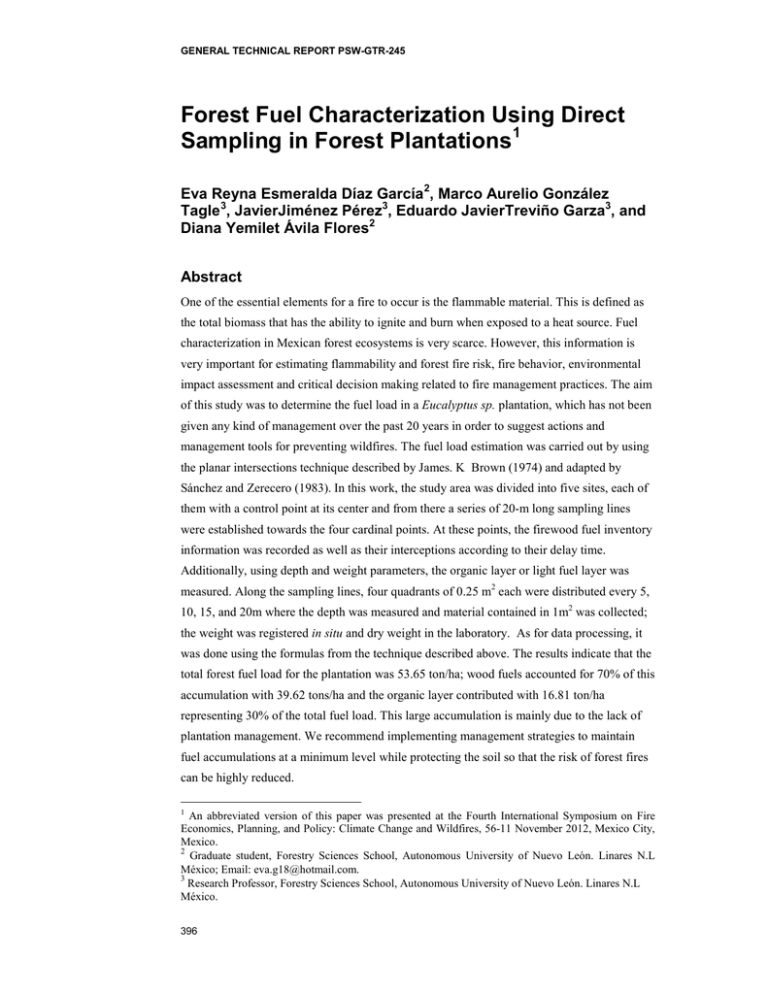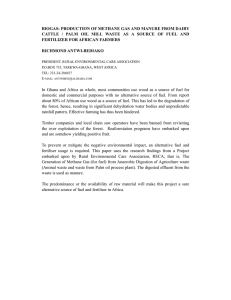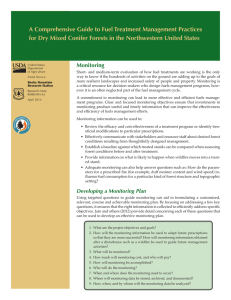Forest Fuel Characterization Using Direct Sampling in Forest Plantations
advertisement

GENERAL TECHNICAL REPORT PSW-GTR-245 Forest Fuel Characterization Using Direct Sampling in Forest Plantations1 Eva Reyna Esmeralda Díaz García 2, Marco Aurelio González Tagle 3, JavierJiménez Pérez3, Eduardo JavierTreviño Garza3, and Diana Yemilet Ávila Flores2 Abstract One of the essential elements for a fire to occur is the flammable material. This is defined as the total biomass that has the ability to ignite and burn when exposed to a heat source. Fuel characterization in Mexican forest ecosystems is very scarce. However, this information is very important for estimating flammability and forest fire risk, fire behavior, environmental impact assessment and critical decision making related to fire management practices. The aim of this study was to determine the fuel load in a Eucalyptus sp. plantation, which has not been given any kind of management over the past 20 years in order to suggest actions and management tools for preventing wildfires. The fuel load estimation was carried out by using the planar intersections technique described by James. K Brown (1974) and adapted by Sánchez and Zerecero (1983). In this work, the study area was divided into five sites, each of them with a control point at its center and from there a series of 20-m long sampling lines were established towards the four cardinal points. At these points, the firewood fuel inventory information was recorded as well as their interceptions according to their delay time. Additionally, using depth and weight parameters, the organic layer or light fuel layer was measured. Along the sampling lines, four quadrants of 0.25 m2 each were distributed every 5, 10, 15, and 20m where the depth was measured and material contained in 1m2 was collected; the weight was registered in situ and dry weight in the laboratory. As for data processing, it was done using the formulas from the technique described above. The results indicate that the total forest fuel load for the plantation was 53.65 ton/ha; wood fuels accounted for 70% of this accumulation with 39.62 tons/ha and the organic layer contributed with 16.81 ton/ha representing 30% of the total fuel load. This large accumulation is mainly due to the lack of plantation management. We recommend implementing management strategies to maintain fuel accumulations at a minimum level while protecting the soil so that the risk of forest fires can be highly reduced. 1 An abbreviated version of this paper was presented at the Fourth International Symposium on Fire Economics, Planning, and Policy: Climate Change and Wildfires, 56-11 November 2012, Mexico City, Mexico. 2 Graduate student, Forestry Sciences School, Autonomous University of Nuevo León. Linares N.L México; Email: eva.g18@hotmail.com. 3 Research Professor, Forestry Sciences School, Autonomous University of Nuevo León. Linares N.L México. 396 Proceedings of the Fourth International Symposium on Fire Economics, Planning, and Policy: Climate Change and Wildfires Keywords: Forest fuels, forest fires, fuel inventory Introduction Fire is one of the greatest enemies of forest resources, which along with pests and diseases cause tree deaths, making these, in turn, significant deforestation and degradation factors. In recent years, Mexico has been significantly affected by fires that occur every year, being an ecological factor and one of the most common phenomena in our forest ecosystems, especially in drought times where the fire risk significantly increases because of the large dry organic fuel accumulations. However, in Mexico the main cause of the high incidence of fires is human actions, because more than 90% of yearly fires are due to traditional practices and inappropriate use of fire (agriculture and intentional burning for various reasons in forest areas). For a fire to develop, it needs the interaction of biological factors that influence fire occurrence and behavior. These factors are mainly climate, weather, topography and fuel material (DeBano 1998). The latter is a very important variable in determining the danger created and the development of forest fires, as these materials directly influence fire behavior. Forest Fuels Forest fuel is made up of wood and light materials, living or dead; all are plant matter present in an ecosystem that has the ability to ignite and burn when exposed to a heat source. These fuels are the result of the natural process of leaf, needle and branch fall, as well as humus, although they are also due to human activities, like forest harvesting. Forest fuels are classified under different criteria according to their weight, size, and state of decomposition or location; however, the most common classification is according to their delay time. That is, the time it takes a dead plant fuel to gain or lose two-thirds of the difference between its initial moisture content and its equilibrium moisture content with respect to the environment (Brown 1982). The larger the fuel, the more slowly it will lose or gain moisture and the longer its delay time will be. Thus, the diameter will establish the fuel delay time. 397 GENERAL TECHNICAL REPORT PSW-GTR-245 Table 1—Classification of forest fuels Diameter Delay time Less than 0.6 cm Size and weight 1 hour Fine/Light From 0.6 to 2.5 cm 10 hours Small/Light From 2.6 to 7.5 cm 100 hours Higher than 7.5 cm 1000 hours Regular/Medium Big/Heavy Hour fuels, also called fine fuels, such as leaves and branches are easily ignited and rapidly consumed by fire when they are dry. Ten hour fuels, known as light fuels, are mainly twigs. One hundred hour fuels, or medium fuels, are branches. As for thousand hour fuels, they are known as heavy fuels and consist mainly of thick branches and wood logs. Also in this category, the trunks or branches that are in a state of decay and those which are in a firm state or not rotten are clearly differentiated. Although these fuels protect the soil, it is necessary that the forming layer is not so deep that it facilitates fire dispersion. Therefore, it is necessary to implement management strategies that favor fuel reduction, while protecting the soils, as well as carry out fuel characterizations and spatial distribution studies. Forest Fuel Estimation The fuel loading estimate was carried out by the planar intersections technique, which was described by James K. Brown (1974) and adapted to Mexico by Sánchez and Zerecero (1983). This technique consists of counting the interceptions of woody parts in vertical sampling planes, similar to "guillotines cutting” fallen fuels and on the ground it is marked with a sampling line. Some basic rules of this technique are: 1. Fuels that should be measured include dead woody material (twigs, stems, branches or stumps) of trees and shrubs, which have fallen to the ground surface and are separated from the original growth source. Therefore, dead branches that are attached to the trunks of standing trees should be omitted. 2. Branches or twigs that are in or on the litter layer must be considered. However, if the twig lies within the humus layer it must not be measured. 3. If the sampling plane intercepts the end of a log, this will only be measured if the sample plane crosses its central axis. 4. Pieces whose central axis coincides exactly with the sample line will not be measured (event that rarely occurs). 5. If the sampling plane intercepts more than once a curved piece, each intersection will be measured. 398 Proceedings of the Fourth International Symposium on Fire Economics, Planning, and Policy: Climate Change and Wildfires 6. If there are woodchips or small pieces of wood left after harvesting, they must be studied inside cylinders to determine shape, size, class and record their diameters. 7. Stumps, whether rooted or not, that are covered by soil should be measured. For this, non-fixed trunks are considered as tree trunks or individual roots, depending on where they are intercepted by the sample line. Stumps without alteration should not be measured. Methods Study area The study area is located in the Linares municipality (Nuevo León, Mexico) at 350 meters above sea level (masl), with coordinates 24° 47' north latitude and 99° 32' west longitude (SPP-INEGI 1986) on the Linares-Ciudad Victoria Highway (kilometer 145). This area corresponds to a Eucalyptus microtheca and Eucalyptus camaldulensis plantation which is 1.98 ha in area. This plantation is located in the experimental campus of the Forestry Faculty at the Autonomous University of Nuevo León. Parcel delimitation The study area was divided into two quadrants (CI and CII). In CI, three sites of 40m x 40m were delimited, with an approximate area of 1,600 m2. In CII, two parcels of the same dimensions were delimited. The size of these parcels is considered acceptable compared to those used by Flores and Benavides (1994 and 1995) that were 20m x 30m, and those used by Alvarado (1988) in two of his works, which measured 10m x 20m. Measured variables The fuel variables were: PROF and PE-HO/HU= litter and humus depth and weight (cm); PE-CO= organic layer weight (t/ ha); PE-1HR= fuel weight with 1h delay time (t/ha); PE-1O HR= fuel weight with 10h delay time (t/ha); PE-100 HR= fuel weight with 100h delay time (t/ha); PE-1000 HR FIRM= weight of solid fuels with 1,000h delay time (t/ha) and PE-1000 ROTTEN= rotten fuel weight with 1,000h delay time (t/ha). Sampling Design 399 GENERAL TECHNICAL REPORT PSW-GTR-245 The measurements were taken under the following sampling design: at each site, four sampling lines were established having a total of 20 sampling lines/ha because as a general rule, it is suggested to have from 15 to 20 lines in any study area, as this number would produce estimates with 20% or less error (Sánchez and Zerecero 1983). The line length was 20 meters long and heading towards the cardinal points. In the first meter of the sampling line, the frequencies were recorded for fuels with a diameter <0.06 cm, (PE-1HR) in four meters the fuels with a diameter 0.6-2.5 cm were recorded, (PE-1OHR) in the next 6 meters the fuels with a diameter 2.6-7.5 cm were recorded, (PE-100 HR) and lastly, in the 20 meters the fuels with a diameter of > 7.5 cm were recorded as well as their state: firm or rotten (PE-1,000 HR). A caliper was used for measuring woody fuel categories with previously established measurements. Heavy fuels Quadrant for the fuel bed Medium Fuels Small Fuels Light Fuels Figure 1—Sampling design. The total length of the sampling line was 20 m, and it was divided into sections in order to record fuel frequency by diameter category. It also shows the quadrant locations for the evaluation of the fuel bed. For the organic layer evaluation (Image 1), four quadrants of 0.25m2 were distributed every 5, 10, 15, and 20m along the sampling line (where the organic matter and humus layer depth were measured). As for litter weight in each quadrant, 400 Proceedings of the Fourth International Symposium on Fire Economics, Planning, and Policy: Climate Change and Wildfires the material contained in 1m2 was collected; the weight was recorded in situ and the dry weight in the laboratory for dry matter per hectare calculations. Image 1— Left: Sampling lines established in the field for carrying out the forest fuel inventory. Right: Calipers used for measuring fuel material intercepted by the sampling line. Forest Fuel Weight Calculation The dataset derived from the fuel inventory was evaluated in a database created in Excel using formulas, according to Sánchez and Zerecero (1983), which determine the amount of fuel in ton/ ha. Table 2— Formulas used to estimate forest fuels. Class size (cm) 0-0.6 Formula p= 0.484 x f x c NI 0.6-2.5 p= 3.369 x f x c NI 2.5-7.5 p= 36.808 x f x c NI >7.5 (not rotten) p= 1.46 x d2 x c NI > 7.5 (rotten) p= 1.21 x d2 x c NI 401 GENERAL TECHNICAL REPORT PSW-GTR-245 Where p is fuel weight, expressed in metric tons per hectare, f is frequency or number of interceptions, c is a slope correction factor, d2 is sum of squares of the diameters of the branches and logs, and NI is total length of the sample line or sum of the lengths of the lines, in linear feet. In order to obtain the litter or light fuel weight in ton/ ha, the obtained samples were dried in an oven at 75°C until they reached constant weight, then the conversion to tons of litter per hectare was done. Also, with the data obtained from litter depth, the arithmetic mean of all sites was calculated. Results and Discussion Below are the values obtained from the forest fuel inventory (Table 3). Table 3—Fuel load in the study area and arithmetic mean of the depth measurements obtained in the organic layer. Fuel loads in the study area according to their delay time (Ton/ha) Site 1H 10 H 100 H 1,000 H non rotten 1,000 H rotten Light (OM) Total Organic layer depth (cm) I 0.44 1.21 8.88 0 0.58 3.08 14.19 2.86 II 0.62 1.92 0.46 0 0 2.96 5.96 4.44 III 0.47 1.21 5.14 0 1.69 3.51 12.02 4.33 IV 0.73 2.18 2.80 0 0.58 4.16 10.45 3.21 V 0.59 2.24 7.01 0 0.86 3.10 13.81 3.07 Ton/ha = 2.87 8.71 24.31 0 3.73 16.81 56.43 Highest forest fuel amounts were found in sites I and V (Fig. 2), where it can be observed graphically that these two sites are nearly in the same range; similarly, site II showed the lowest fuel accumulation. 402 Proceedings of the Fourth International Symposium on Fire Economics, Planning, and Policy: Climate Change and Wildfires Total forest fuel loads I II Sites Figure 2—Total forest fuel loads per site. The forest fuels with the highest accumulation in the planting area are those with a 100h delay time, representing 70% of the total woody material, which was 39.65 ton/ha, of which 24.31 ton/ha correspond to these materials). The 1h fuels had the lowest accumulation, contributing only 2.87 ton/ha. Figure 3 — Wood fuels by time delay (ton/ ha) The fuel load of the organic layer contributes with 16.81 ton/ ha, representing 30% of the total load in the study area. It can be seen that the highest accumulation of light fuels is in site IV, in contrast with the lowest accumulation of these fuels in site II. 403 GENERAL TECHNICAL REPORT PSW-GTR-245 Organic layer fuel load I II III VI V Sites Figure 4—Organic layer fuel load The arithmetic mean of the organic layer depth for the entire study area was 3.58 cm. The depth for I and III sites are in the same range, which is similar to sites VI and V; in site I, the organic matter layer was not as deep. Depth I II III VI V Sites Figure 5 — Organic layer depth Conclusions Results indicate that due to the absence of management, there is a large accumulation of forest fuels that increases fire risk. The implementation of fuel management tools, such as mechanical fuel removal or a controlled burn to reduce fuel availability, taking into account the guidelines established in the NOM-015-SEMARNAT/SAGARPA-2007, is recommended. 404 Proceedings of the Fourth International Symposium on Fire Economics, Planning, and Policy: Climate Change and Wildfires Furthermore, in the long term, the fuel accumulation time should be monitored in order to establish a controlled fuel control cycle and thus minimize forest fuel accumulation. References Alvarado C.E. 1988. Estimación del consumo por el fuego de combustibles forestales en rodales de Pinus montezumae Lamb. Combustibles muertos. Agrociencia 72: 74-85 pp. Colegio de Postgraduados. Montecillo, México. Bermúdez M.E; Anima J.B; Hernández J.A; González J.C. 2008. Criterios para Evaluar Combustibles en Áreas Forestales. INIFAP. Folleto Técnico Núm 3. Primera Edición.35p. Brown, J.K. 1974. Handbook for inventorying downed woody material. USDA Forest Service. General Technical Report INT – 16. Utah, USA. 24 p DeBano, L. 1998, Fire’s Effects on Ecosystems, John Wiley and Sons, Inc. Flores Garnica, J. G., Benavides S., J. de D. 1994. Efecto de dos tipos de quemas controladas en bosques de pino en Jalisco. Folleto técnico Núm. 5. CIPACJALISCO, INIFAP, SARH. México. 12 p. Flores Garnica, J.G., Moreno G., A.D. Morfín R., J.E. 2010. Muestreo Directo y Fotoseries en la Evaluación de Combustibles Forestales. INIFAP. Folleto Técnico Núm. 4.Primera Edición. 69 p. Flores Garnica, J.G., Xhelhuantza C., J., Chávez D., A. 2010. Evaluacion del Impacto Ambiental de Incendios Forestales en el Bosque de la Primavera. INIFAP. Folleto Técnico Núm. 5.Primera Edición. 109 p. NájeraD., A. 2004. Manejo de combustibles forestales. Apuntes de la materia Control y Uso del Fuego. Departamento Forestal de la Universidad Autónoma Agraria Antonio Narro. Buenavista, Saltillo, Coahuila, México. NOM-015-SEMARNAT/SAGARPA. 2007. Que establece las especificaciones técnicas de métodos de uso del fuego en los terrenos forestales y en los terrenos de uso agropecuario. Sánchez, C.J., Zerecero, L.G. 1983. Método practico para calcular la cantidad de combustibles leñosos y hojarasca. Nota Divulgativa No 9 CIFONOR – INIF. México. 11 p. 405



